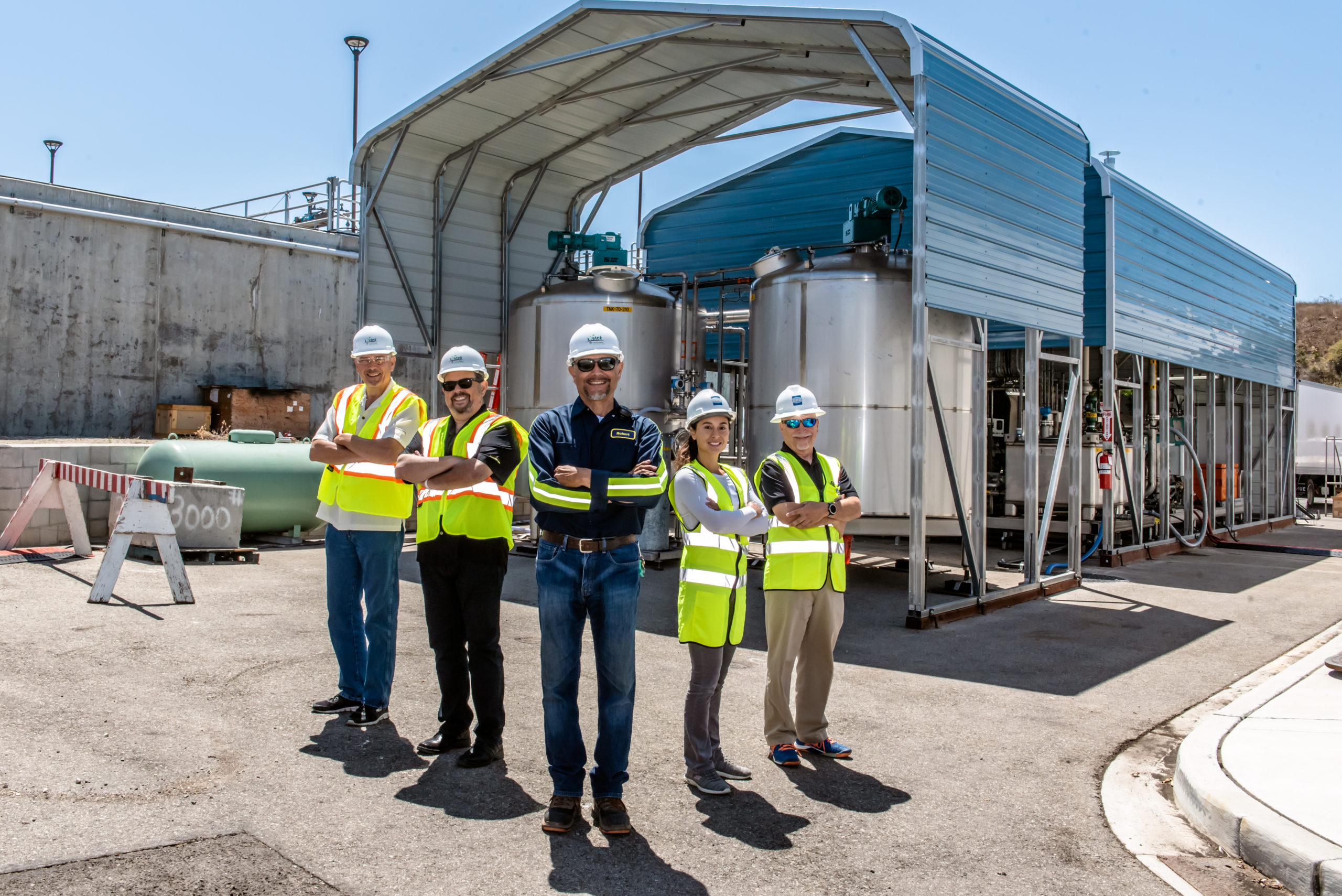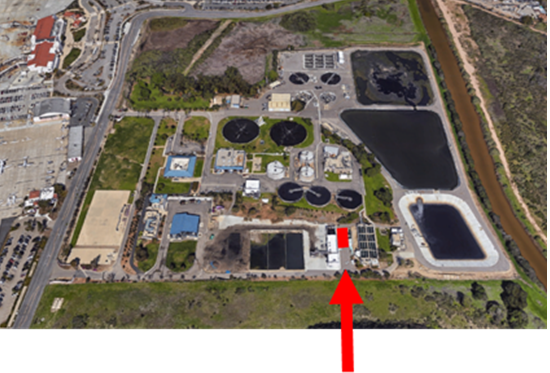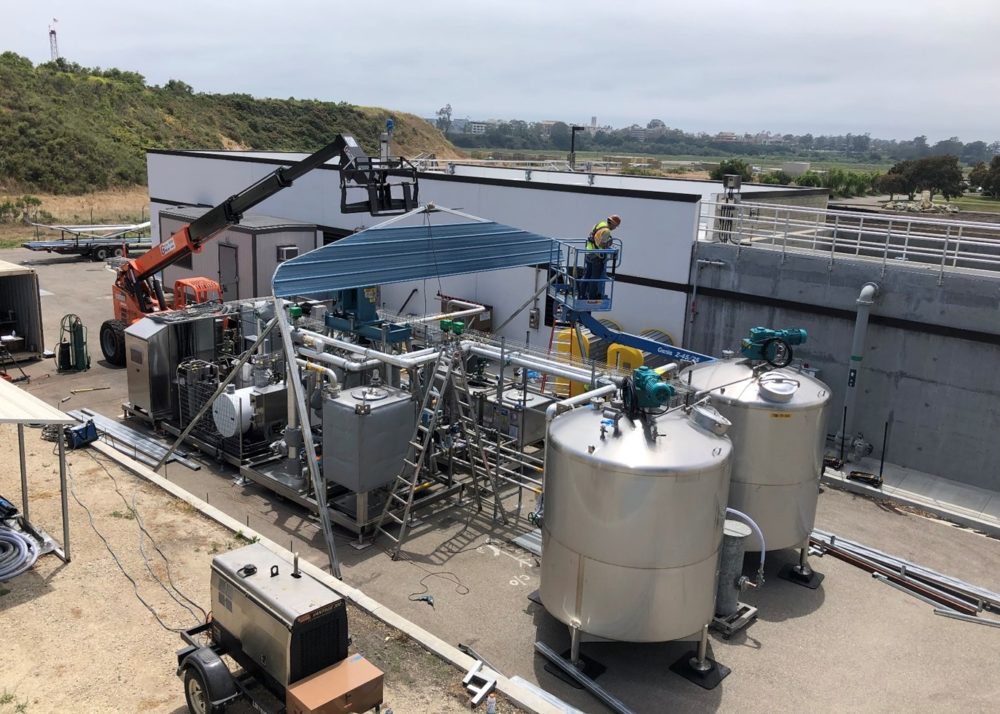
Photo 6: The Lystek and Goleta Sanitary District project team with demonstration equipment in background
Many wastewater plants in California are being besieged with issues which have put stresses on a once traditional industry sector. The days of treating water with proven methods in a fairly stable and static environment are long gone and may never return again. The economic crises of the last decade caused a shuttering of businesses and displacement of populations.
The California droughts of the last 5 years caused increased water conversation and revenue shortfalls throughout the state. And within the last year, the COVID-19 pandemic has caused severe reductions in local business activities and a population being asked to stay/work-at-home.
Add to this the wildfires of 2020 and PSPS (public safety power shutdowns) which caused power supply interruptions. All the while, new legislation has mandated that organic wastes, which causes increasing levels of green-house gas emissions, be diverted and processed to a higher beneficial use, and it seems like wastewater plant operations never get a chance to get into a new-normal routine.

Photo 1: Goleta Sanitary District Facility with Lystek Project Location (Arrow)
But through all of the extra-ordinary events over the last decade, opportunities can be found to make a difference.
Goleta Sanitary District (GSD), in the south coast of Santa Barbara County (Photo 1), has taken steps to keep ahead of the ever-changing world around us. Their vision statement says it all: to be recognized as the region’s leader in water resource recovery through innovation and excellence. This has allowed GSD staff to think outside the box and embrace the latest beneficial technologies and to recover and reuse water, nutrients, and energy through the processes of cleaning wastewater.
From the private sector, Lystek International Limited has made a forceful entry into the biosolids and organic processing field in California. Lystek is a 20-year-old Canadian-based company that entered the California marketplace in 2014 and opened its northern California organics material recovery center in Fairfield soon after.
Lystek approached GSD with an opportunity for a competitive grant from the California Energy Commission (CEC) to demonstrate leading technologies in the processing of organic and food wastes into a digestible material with increased biogas generation capability
The GSD/Lystek team added the University of California-Santa Barbara (UCSB) for the source-separated organics (dining hall food scraps), GHD for grant program assistance and Dudek for CEQA and air permitting assistance.
In March 2017, GSD/Lystek was given notification of a grant award by the CEC as part of their Electric Program Investment Charge (EPIC) program. This program is used to provide funding for applied research and development, technology demonstration and deployment, and market facilitation for clean energy technologies.

Photo 2: Installation of project equipment. Test digesters to the right. Lystek processing equipment in center.
The GSD/Lystek demonstration project is built around a technology process train from organic feedstock acceptance to post-digestion end products and conversion to renewable energy generation. The main technologies used were organics processing and anaerobic digestion. Even though this was a small-scale, state-grant funded project, environmental reviews and air permits were required. GSD acted as lead agency in the CEQA review process and an air permit was received from the Santa Barbara County Air Pollution Control District.
The project equipment was commissioned in Summer 2019. (Photo 2)
The organics processing was performed by using equipment supplied by Smicon, a Dutch-based company with experience in materials handling and processing. The Goleta location allowed Smicon to deploy a demonstration-sized unit as their first-ever US operation
The equipment uses a mechanical combination of a hammer-mill, high-speed rotating trammel and screens to separate the organic matter from the packaging and inorganic fraction (Photo 3).
Dining hall food waste and kitchen scraps were delivered once a week from UCSB to the project site. Due to the levels of plastic bags used, an initial, manual de-bagging sequence was added to facilitate the transfer of slurry through the Smicon unit (Photo 4).
The end result is an oat-meal quality slurry at 8-10 percent solids consistency (Photo 5).
The slurry was then feed into two-equal sized test digesters (roughly 2,500-gallon capacity each) over a regular weekly pumping cycle.
After initial seeding with GSD sludge in August 2019, the organics feed rate was slowly increased to provide a uniform flow rate with a moderate hydraulic retention time (HRT) of approximately 60 days. Continual sampling and testing was made of the test digester material health and levels of biogas generated. The initial results were promising and the input rate was slowly increased to match the desired long-term HRT of 35 days.
This program went on for the remainder of 2019 until UCSB dining hall service was curtailed due to scheduled holidays in late December. The project used granular sugar as a feedstock substitute during this prolonged absence of food waste and the test results continued to show acceptable degree of digestion performance.
However, in mid-March 2020, the source of the food waste was completely stopped due to the emergence of the COVID-19 within the UCSB system. Students were sent off-campus for remote learning and dining hall organics became non-existent. The project team reached out to local restaurants and food service locations, but the same situation was present.
The business lock-down resulted in a lack of consistent organic materials suitable for processing and digestion. Even though the project was not able to complete the length of time or the overall volume of organics processed as originally conceived, enough data had been gathered in the six months of operations to give promise that the project had achieved a level of success consistent with the goals of the grant.
The depackaging equipment was able to produce a digestible feedstock with acceptable quality for anaerobic digestion. The organic breakdown for the mono-digestion was within the pre-project calculated range of 75%-90% biodegradability and the resultant biogas generated was enough to justify a larger scale project if desired.
The complete project details are currently being prepared as a final grant report for the CEC. The expected date of publication is in mid-2021.
While the unexpected shutdown curtailed completion of the study as intended, the project team looked to turn a potential lemon into sweet lemonade. The project infrastructure included the Lystek thermal hydrolysis process (THP) as part of the overall grant program.
With the loss of a reliable source of organics, individual food sources were used to perform hydrolysis on the organic slurry and then digestion. The results showed a marked improvement in organic destruction and increased biogas as compared to direct digestion of organic slurry. This testing was run for about 2 months until even the alternative sources of organic waste became irregular and unreliable.
The project is presently continuing as a further proof of concept for producing end product material for re-feeding into full-scale digesters used by GSD. The concept is to take anaerobically digested and dewatered biosolids and process them through the Lystek THP technology. The resultant material is then re-feed back into the anaerobic digester(s) to improve overall digestion performance and increase biogas production.
This process is currently underway and is showing results in substantially higher volatile solids breakdown, higher gas yields, and measurably reduced biosolids volumes requiring offsite management. This triple-play fits exactly into the vision and mission of GSD and advances the Lystek technology into a commercial-size deployment opportunity.
Overall, as in other demonstration-type set-ups, challenges were encountered during the start-up and operational phases. But the system proved to be robust enough that end results could be quantified and provide supporting documentation for further development. The GSD and Lystek team (Photo 6) have worked in close partnership to better understand the role that organics management has at wastewater treatment plants.
The opportunities to generate a renewable energy source, and further that with onsite power production or redundancy, along with reduced financial stresses on solids management, gives one direction for the wastewater industry to see a self-sustaining future where predictable and unpredictable events become non-issues.